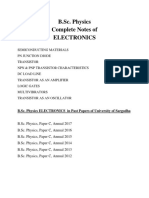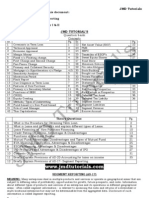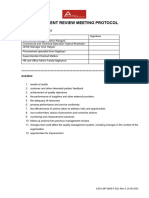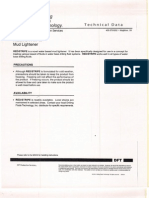Semiconductor Basics
Semiconductor Basics
Uploaded by
PhillimonCopyright:
Available Formats
Semiconductor Basics
Semiconductor Basics
Uploaded by
PhillimonCopyright
Available Formats
Share this document
Did you find this document useful?
Is this content inappropriate?
Copyright:
Available Formats
Semiconductor Basics
Semiconductor Basics
Uploaded by
PhillimonCopyright:
Available Formats
Semiconductor Basics
Semiconductors materials such as silicon (Si), germanium (Ge) and gallium arsenide (GaAs), have electrical properties somewhere in the middle, between those of a "conductor" and an "insulator". They are not good conductors nor good insulators (hence their name "semi"conductors). They have very few "fee electrons" because their atoms are closely grouped together in a crystalline pattern called a "crystal lattice". However, their ability to conduct electricity can be greatly improved by adding certain "impurities" to this crystalline structure thereby, producing more free electrons than holes or vice versa.
Silicon Semiconductor
By controlling the amount of impurities added to the semiconductor material it is possible to control its conductivity. These impurities are called donors or acceptors depending on whether they produce electrons or holes respectively. This process of adding impurity atoms to semiconductor atoms (the order of 1 impurity atom per 10 million (or more) atoms of the semiconductor) is called Doping. The most commonly used semiconductor basics material by far is silicon. Silicon has four valence electrons in its outermost shell which it shares with its neighbouring silicon atoms to form full orbital's of eight electrons. The structure of the bond between the two silicon atoms is such that each atom shares one electron with its neighbour making the bond very stable. As there are very few free electrons available to move around the silicon crystal, crystals of pure silicon (or germanium) are therefore good insulators, or at the very least very high value resistors. Silicon atoms are arranged in a definite symmetrical pattern making them a crystalline solid structure. A crystal of pure silica (silicon dioxide or glass) is generally said to be an intrinsic crystal (it has no impurities) and therefore has no free electrons. But simply connecting a silicon crystal to a battery supply is not enough to extract an electric current from it. To do that we need to create a "positive" and a "negative" pole within the silicon allowing electrons and therefore electric current to flow out of the silicon. These poles are created by doping the silicon with certain impurities.
A Silicon Atom Structure
The diagram above shows the structure and lattice of a 'normal' pure crystal of Silicon.
N-type Semiconductor Basics
In order for our silicon crystal to conduct electricity, we need to introduce an impurity atom such as Arsenic, Antimony or Phosphorus into the crystalline structure making it extrinsic (impurities are added). These atoms have five outer electrons in their outermost orbital to share with neighbouring atoms and are commonly called "Pentavalent" impurities. This allows four out of the five orbital electrons to bond with its neighbouring silicon atoms leaving one "free electron" to become mobile when an electrical voltage is applied (electron flow). As each impurity atom "donates" one electron, pentavalent atoms are generally known as "donors". Antimony (symbol Sb) or Phosphorus (symbol P), are frequently used as a pentavalent additive to the silicon as they have 51 electrons arranged in five shells around their nucleus with the outermost orbital having five electrons. The resulting semiconductor basics material has an excess of current-carrying electrons, each with a negative charge, and is therefore referred to as an "N-type" material with the electrons called "Majority Carriers" while the resulting holes are called "Minority Carriers". When stimulated by an external power source, the electrons freed from the silicon atoms by this stimulation are quickly replaced by the free electrons available from the doped Antimony atoms. But this action still leaves an extra electron (the freed electron) floating around the doped crystal making it negatively charged. Then a semiconductor material is classed as N-type when its donor density is greater than its acceptor density, in other words, it has more electrons than holes thereby creating a negative pole as shown.
Antimony Atom and Doping
The diagram above shows the structure and lattice of the donor impurity atom Antimony.
P-Type Semiconductor Basics
If we go the other way, and introduce a "Trivalent" (3-electron) impurity into the crystalline structure, such as Aluminum, Boron or Indium, which have only three valence electrons available in their outermost orbital, the fourth closed bond cannot be formed. Therefore, a complete connection is not possible, giving the semiconductor material an abundance of positively charged carriers known as "holes" in the structure of the crystal where electrons are effectively missing. As there is now a hole in the silicon crystal, a neighboring electron is attracted to it and will try to move into the hole to fill it. However, the electron filling the hole leaves another hole behind it as it moves. This in turn attracts another electron which in turn creates another hole behind it, and so forth giving the appearance that the holes are moving as a positive charge through the crystal structure (conventional current flow). This movement of holes results in a shortage of electrons in the silicon turning the entire doped crystal into a positive pole. As each impurity atom generates a hole, trivalent impurities are generally known as "Acceptors" as they are continually "accepting" extra or free electrons. Boron (symbol B) is commonly used as a trivalent additive as it has only five electrons arranged in three shells around its nucleus with the outermost orbital having only three electrons. The doping of Boron atoms causes conduction to consist mainly of positive charge carriers resulting in a "P-type" material with the positive holes being called "Majority Carriers" while the free electrons are called "Minority Carriers". Then a semiconductor basics material is classed as Ptype when its acceptor density is greater than its donor density. Therefore, a P-type semiconductor has more holes than electrons.
Boron Atom and Doping
The diagram above shows the structure and lattice of the acceptor impurity atom Boron.
Semiconductor Basics Summary
N-type (e.g. add Antimony)
These are materials which have Pentavalent impurity atoms (Donors) added and conduct by "electron" movement and are called, N-type Semiconductors. In these types of materials are:
1. The Donors are positively charged. 2. There are a large number of free electrons. 3. A small number of holes in relation to the number of free electrons. 4. Doping gives:
o o o o
positively charged donors. negatively charged free electrons.
5. Supply of energy gives:
o o o o
negatively charged free electrons. positively charged holes.
P-type (e.g. add Boron)
These are materials which have Trivalent impurity atoms (Acceptors) added and conduct by "hole" movement and are called, P-type Semiconductors. In these types of materials are:
1. The Acceptors are negatively charged. 2. There are a large number of holes. 3. A small number of free electrons in relation to the number of holes. 4. Doping gives:
o o o o
negatively charged acceptors. positively charged holes.
5. Supply of energy gives: o positively charged holes. o negatively charged free electrons.
and both P and N-types as a whole, are electrically neutral on their own. Antimony (Sb) and Boron (B) are two of the most commonly used doping agents as they are more freely available compared to other types of materials. They are also classed as "metalloids". However, the periodic table groups together a number of other different chemical elements all with either three, or five electrons in their outermost orbital shell making them suitable as a doping material.
Conductors and Non-Conductors
An electric current occurs when there is a flow of electrons in a certain direction. As electrons have a negative charge, their movement means that charge is flowing from one point to another and this is what an electric current is. To enable the current to flow the electrons must be able to move freely within the material. In some materials electrons are moving freely around the lattice, although the number of electrons and the available spaces for them balances out so the material itself does not carry a charge. In these materials the electrons are moving freely but randomly. By placing a potential difference across the conductor the electrons can be made to drift in one direction and this constitutes an electric current. Many materials are able to conduct electricity, but metals form the most common examples.
Unlike metals, there are many other materials in which all the electrons are firmly bound to their parent molecules and they are not free to move. Accordingly when a potential is placed across the substance very few electrons will be able to move and very little or no current will flow. These substances are called non-conductors or insulators. They include most plastics, ceramics and many naturally occurring substances like wood.
Semiconductors
Semiconductors do not fall into either the conductor or non-conductor categories. Instead they fall in between. A variety of materials fall into this category, and they include silicon, germanium, gallium arsenide, and a variety of other substances. In its pure state silicon is an insulator with no free electrons in the crystal lattice. However to understand how it acts as a semiconductor first look at the atomic structure of silicon in its pure state. Each molecule in the crystal lattice consists of a nucleus with three rings or orbits containing electrons, and each electron has a negative charge. The nucleus consists of neutrons that are neutral and have no charge, and protons that have a positive charge. In the atom there are the same number of protons and electrons so the whole atom has no overall charge. The electrons in the silicon, as in any other element are arranged in rings with strict numbers of electrons in each orbit. The first ring can only contain two, and the second has eight. The third and outer ring of the silicon has four. The electrons in the outer shell are shared with those from adjacent atoms to make up a crystal lattice. When this happens there are no free electrons in the lattice, making silicon a good insulator. A similar picture can be seen for germanium. It has two electrons in the inner most orbit, eight in the next, 18 in the third, and four in the outer one. Again it shares its electrons with those from adjacent atoms to make a crystal lattice without any free electrons.
Impurities
In order to make silicon or any other semiconductor into a partially conducting material it is necessary to add a very small amount of impurity into the material. This considerably changes the properties. If traces of impurities of materials having five electrons in the outer ring of their atoms are added they enter the crystal lattice sharing electrons with the silicon. However as they have one extra electron in the outer ring, one electron becomes free to move around the lattice. This enables a current to flow if a potential is applied across the material. As this type of material has a surplus of electrons in the lattice it is known as an N-type semiconductor. Typical impurities that are often used to create N-type semiconductors are phosphorous and arsenic.
It is also possible to place elements with only three electrons in their outer shell into the crystal lattice. When this happens the silicon wants to share its four electrons with another atom with four atoms. However as the impurity only has three, there is a space or a hole for another electron. As this type of material has electrons missing it is known as P-type material. Typical impurities used for P-type material are boron, and aluminium.
Holes
It is easy to see how electrons can move around the lattice and carry a current. However it is not quite so obvious for holes. This happens when an electron from a complete orbit moves to fill a hole, leaving a hole where it came from. Another electron from another orbit can then move in to fill the new hole and so forth. The movement of the holes in one direction corresponds to a movement of electrons in the other, hence an electric current. From this it can be seen that either electrons or holes can carry charge or an electric current. As a result, they are known as charge carriers, holes being the charge carriers for a P-type semiconductor and electrons for an N-type semiconductor.
Summary
The principle behind semiconductors can look fairly straightforward. However it took many years before many of its properties could be exploited, and many more before they could be refined. Nowadays, many of the processes used with semiconductors have been highly optimised and the components like integrated circuits are highly sophisticated. However they rely on the fact that different areas of the semiconductor can be doped to make P-type and N-type semiconductors.
List of common semiconductor terms
Charge carrier - Charge carrier is a free a free (mobile, unbound) particle carrying an electric charge, e.g. an electron or a hole.
Conductor - A material in which electrons can move freely and electricity can flow.
Electron - A sub-atomic particle carrying a negative charge.
Hole - The absence of a valence electron in a semiconductor crystal. The motion of a hole is equivalent to motion of a positive charge, i.e. opposite to the motion of an electron.
Insulator - A material in which there are no free electrons available to carry electricity.
Majority carrier - Current carriers, either free electrons or holes that are in excess i.e. in the majority in a specific area of a semiconductor material. Electrons are the majority carriers in N-type semiconductor, and holes in a P-type area.
Minority carrier - Current carriers, either free electrons or holes that are in the minority in a specific area of a semiconductor material
N-type - An area of a semiconductor in which there is an excess of electrons.
P-type - An area of a semiconductor in which there is an excess of holes.
Semiconductor - A material that is neither an insulator nor a full conductor that has an intermediate level of electrical conductivity and in which conduction takes place by means of holes and electrons.
You might also like
- Electronics BSc..Document45 pagesElectronics BSc..Fida Ur RehmanNo ratings yet
- ECE 301 Electrical Engineering Materials 2Document28 pagesECE 301 Electrical Engineering Materials 2David ToonsNo ratings yet
- Outreach 11Document24 pagesOutreach 11amanuelfitsum589No ratings yet
- Lecture 01 2Document17 pagesLecture 01 2সায়েম মুহাম্মাদNo ratings yet
- Project Report On SemiconductorsDocument6 pagesProject Report On SemiconductorsokgoogleNo ratings yet
- Semiconductor PhysicsDocument15 pagesSemiconductor PhysicsjhonalejoNo ratings yet
- SemiconductorsDocument6 pagesSemiconductorsNikhil KumarNo ratings yet
- Solid State FundamentalsDocument38 pagesSolid State FundamentalsJed Drey AlejandroNo ratings yet
- Basic Semiconductor TheoryDocument27 pagesBasic Semiconductor TheorymebrahtenNo ratings yet
- الالكترونيات التماثليةDocument98 pagesالالكترونيات التماثليةSara AsdfNo ratings yet
- EEC121 Module 2Document13 pagesEEC121 Module 2somtoonyeanusi38No ratings yet
- BASIC ELECTRONICS Lecture 1Document18 pagesBASIC ELECTRONICS Lecture 1Alex HenryNo ratings yet
- Band Theory of SolidsDocument7 pagesBand Theory of SolidsMohit KambojNo ratings yet
- Electronics Basic & Semiconductor 2Document20 pagesElectronics Basic & Semiconductor 2Krishanu NaskarNo ratings yet
- Semiconductor Basics: ResistorsDocument11 pagesSemiconductor Basics: ResistorsJohn Brix BalisterosNo ratings yet
- Understanding The P-N JunctionDocument21 pagesUnderstanding The P-N JunctionwarrenronaldNo ratings yet
- Semiconductor PresentationDocument34 pagesSemiconductor PresentationMarphe M. RenoballesNo ratings yet
- Integrated CircuitsDocument68 pagesIntegrated CircuitskhaledNo ratings yet
- Fundamentals of Electronic CircuitDocument4 pagesFundamentals of Electronic CircuitNetflix OasanNo ratings yet
- Chapter 1 Introduction (Semiconductors)Document33 pagesChapter 1 Introduction (Semiconductors)Marshall HarperNo ratings yet
- Unit ElectronicDocument9 pagesUnit ElectronicSris Jame'No ratings yet
- Week 3 Solar EnergyDocument18 pagesWeek 3 Solar EnergyAleydaNo ratings yet
- Lesson 1 Review QuestionsDocument4 pagesLesson 1 Review Questionsjesstinelitan2004No ratings yet
- Chapter One & Two NewDocument168 pagesChapter One & Two NewTolesa ShoreNo ratings yet
- Crystals and Band Theory Bonding in Metals: The Electron Sea ModelDocument6 pagesCrystals and Band Theory Bonding in Metals: The Electron Sea ModelJeric TapusokNo ratings yet
- Modul Semiconductor 1Document1 pageModul Semiconductor 1Lis LisNo ratings yet
- Unit - III: Semiconductor Materials: SemiconductorsDocument9 pagesUnit - III: Semiconductor Materials: SemiconductorsDeependra SinghNo ratings yet
- Conductive Polymers: Why They Were Worth The Nobel PrizeDocument21 pagesConductive Polymers: Why They Were Worth The Nobel PrizeAnthony WitribeNo ratings yet
- Dee20023 - Chapter 1Document39 pagesDee20023 - Chapter 1Aiman AsyraafNo ratings yet
- Lecture 2Document41 pagesLecture 2mezz3174444No ratings yet
- SemiconductorsDocument17 pagesSemiconductorsHarishNo ratings yet
- How Solar Cells WorkDocument14 pagesHow Solar Cells WorkMonicaNo ratings yet
- Final Chap - 4 Band Theory of Solids SemiconductorsDocument25 pagesFinal Chap - 4 Band Theory of Solids Semiconductorskunal0000041No ratings yet
- How Do Solar Panels WorkDocument6 pagesHow Do Solar Panels WorkprabuparthibanNo ratings yet
- Chapter One: Introduction To ElectronicsDocument7 pagesChapter One: Introduction To ElectronicsBereket TsegayeNo ratings yet
- Semiconductors (DEE 1201)Document12 pagesSemiconductors (DEE 1201)kawisojames10No ratings yet
- Introduction To ElectronicsDocument28 pagesIntroduction To ElectronicsJed Drey AlejandroNo ratings yet
- Semiconductors:: N Is The Number of The Electron ShellsDocument9 pagesSemiconductors:: N Is The Number of The Electron ShellsfarexanNo ratings yet
- 2008 Physics NotesDocument12 pages2008 Physics NotesAbdullionNo ratings yet
- Physics For EngineersDocument74 pagesPhysics For EngineersJohn ZhouNo ratings yet
- ELECTRONICS COURSE Fundamentals RevisedDocument75 pagesELECTRONICS COURSE Fundamentals RevisedErica Mae GolpeoNo ratings yet
- Electrons and ''Holes'' - S.Document5 pagesElectrons and ''Holes'' - S.Manikandan SundararajNo ratings yet
- TitleDocument4 pagesTitlejerry duqueNo ratings yet
- Electronics 1: Ahsan KhawajaDocument36 pagesElectronics 1: Ahsan KhawajaSyed AhsanNo ratings yet
- ENT 162 - Ch1Document40 pagesENT 162 - Ch1Dancen OoNo ratings yet
- METALS - Band-TheoryDocument7 pagesMETALS - Band-TheoryAbdulgaffor BaimpalNo ratings yet
- DiodeDocument43 pagesDiodemansemsemNo ratings yet
- Intrinsic Semiconductors Are Pure Semiconductor, Their Conductivity Is Poor and As Such They Do Not FindDocument2 pagesIntrinsic Semiconductors Are Pure Semiconductor, Their Conductivity Is Poor and As Such They Do Not FindJessa San PedroNo ratings yet
- Lecture 1Document28 pagesLecture 1abram samNo ratings yet
- PHY 322 Semiconductors and Semiconductor DiodeDocument27 pagesPHY 322 Semiconductors and Semiconductor DiodeAlex William JohnNo ratings yet
- 1 Semiconductor Materials PDFDocument5 pages1 Semiconductor Materials PDFpakistanpkNo ratings yet
- Semiconductor-Band StructureDocument8 pagesSemiconductor-Band StructureSuvrodeep DebnathNo ratings yet
- Review of Semiconductor Physics, PN Junction Diodes and ResistorsDocument45 pagesReview of Semiconductor Physics, PN Junction Diodes and ResistorsDinEAminShoiloNo ratings yet
- Unit-1-V EM NOTESDocument171 pagesUnit-1-V EM NOTESதமிழ் என் உயிர்No ratings yet
- Basic Electronics Semiconductors - L3 GoodDocument20 pagesBasic Electronics Semiconductors - L3 GoodjinxedtraviniaNo ratings yet
- Publication 12 27858 153Document9 pagesPublication 12 27858 153Yarrabhumi SainathreddyNo ratings yet
- Semi ConducterDocument59 pagesSemi ConducterSaurabh PandeyNo ratings yet
- Physics Investigatory 2 PDF FreeDocument24 pagesPhysics Investigatory 2 PDF FreekirtanNo ratings yet
- Correlation Course in ElectronicsDocument5 pagesCorrelation Course in ElectronicsCarmie BasilloteNo ratings yet
- Practice Sheet ALKENESDocument4 pagesPractice Sheet ALKENESPhillimonNo ratings yet
- Primary AminesDocument12 pagesPrimary AminesPhillimonNo ratings yet
- Contrasting MO and VB TheoryDocument4 pagesContrasting MO and VB TheoryPhillimonNo ratings yet
- AlkenesDocument11 pagesAlkenesPhillimonNo ratings yet
- KS3 Science 2005 Mark SchemeDocument56 pagesKS3 Science 2005 Mark SchemeMai TruongNo ratings yet
- Pathophysiology - Exam 2 ReviewDocument14 pagesPathophysiology - Exam 2 ReviewWaqas Gill100% (4)
- KT-100S PMI App Note Ver 2.0 2020feb03Document4 pagesKT-100S PMI App Note Ver 2.0 2020feb03Recsa Cahaya ErlanggaNo ratings yet
- Guide To Preparing HSE Plans and Bridging Documents - Supplement To Report 423 (2018 FEB)Document12 pagesGuide To Preparing HSE Plans and Bridging Documents - Supplement To Report 423 (2018 FEB)Htoo Htoo KyawNo ratings yet
- ASN SyllabusDocument1 pageASN SyllabusElango BaskaranNo ratings yet
- PNLE IV For Care of Clients With Physiologic and Psychosocial Alterations (Part 2)Document23 pagesPNLE IV For Care of Clients With Physiologic and Psychosocial Alterations (Part 2)ASDF ASDF100% (1)
- Ent Surgery Cataloge 2019Document90 pagesEnt Surgery Cataloge 2019arif budiantoroNo ratings yet
- RMMJ Gesundheit Maimonides Published Version Jan 2011Document8 pagesRMMJ Gesundheit Maimonides Published Version Jan 2011akiva10bNo ratings yet
- ISAMDocument52 pagesISAMGraciela A JuárezNo ratings yet
- Eck 3900 UpDocument123 pagesEck 3900 Upcristi.capusanNo ratings yet
- Spesifikasi Teknis Barang, EnDO ECG-3Document1 pageSpesifikasi Teknis Barang, EnDO ECG-3Permata HatiNo ratings yet
- Brochure ACUSON ASPENDocument2 pagesBrochure ACUSON ASPENWolaé Mathurin Edmond AmegandjinNo ratings yet
- Victoria TortaDocument1 pageVictoria TortaValéria SzarkaNo ratings yet
- Hunger VS AppetiteDocument2 pagesHunger VS AppetiteKhadija SaeedNo ratings yet
- Physiology of The Menstrual Cycle 1Document22 pagesPhysiology of The Menstrual Cycle 1annonymousNo ratings yet
- Question Bank: JMD TutorialsDocument11 pagesQuestion Bank: JMD TutorialsGrishma MoreNo ratings yet
- MRM RecordDocument6 pagesMRM Recordanarasb5100% (1)
- GR 12 A6 - 7 Add NotesDocument3 pagesGR 12 A6 - 7 Add NotesShaimaa SalamaNo ratings yet
- The Rights of Persons With Disability Act, 2016: Challenges and OpportunitiesDocument8 pagesThe Rights of Persons With Disability Act, 2016: Challenges and Opportunitiesshloka dikshitNo ratings yet
- LM6 Aluminium Casting Alloy: Chemical CompositionDocument3 pagesLM6 Aluminium Casting Alloy: Chemical CompositionNaveendeep Singh CheemaNo ratings yet
- PUMPSDocument25 pagesPUMPScharmaine fosNo ratings yet
- Phaeophyta (Brown Algae)Document22 pagesPhaeophyta (Brown Algae)Sona PectusNo ratings yet
- Of Upright Refrigerator and Freezer: Detailed Instructions For UseDocument44 pagesOf Upright Refrigerator and Freezer: Detailed Instructions For UseVojtech KasparNo ratings yet
- Parts of A CellDocument4 pagesParts of A CellFritz Andre PrimacioNo ratings yet
- ME 24-221 Thermodynamics I Solutions To Assignment 9 November 17, 2000 Fall 2000 J. MurthyDocument4 pagesME 24-221 Thermodynamics I Solutions To Assignment 9 November 17, 2000 Fall 2000 J. MurthyMarcelo AlegriaNo ratings yet
- On Semiconductor 2N7000 D26Z DatasheetDocument8 pagesOn Semiconductor 2N7000 D26Z DatasheetVũ Huy Nhật MinhNo ratings yet
- Bridge Technical Note 2012 - 003 Design of Integral and Semiintegral BridgesDocument2 pagesBridge Technical Note 2012 - 003 Design of Integral and Semiintegral BridgesŁukaszPiechówkaNo ratings yet
- Micro Perspective Lesson 1Document8 pagesMicro Perspective Lesson 1Meryjoy MesaNo ratings yet
- Red Stripe Mud LightnerDocument6 pagesRed Stripe Mud LightnerChris SniderNo ratings yet
- Ashley Sailer: Cooking Up Wurha'S SuccessDocument13 pagesAshley Sailer: Cooking Up Wurha'S SuccesswurhaoNo ratings yet





























































































